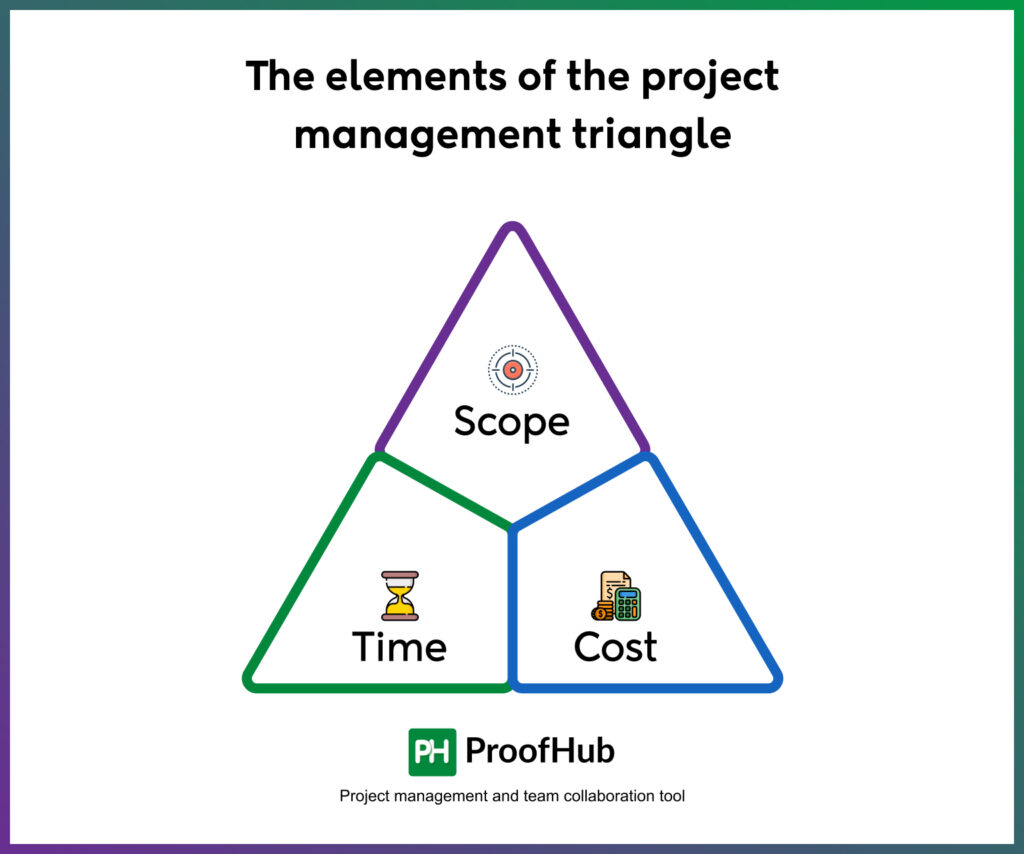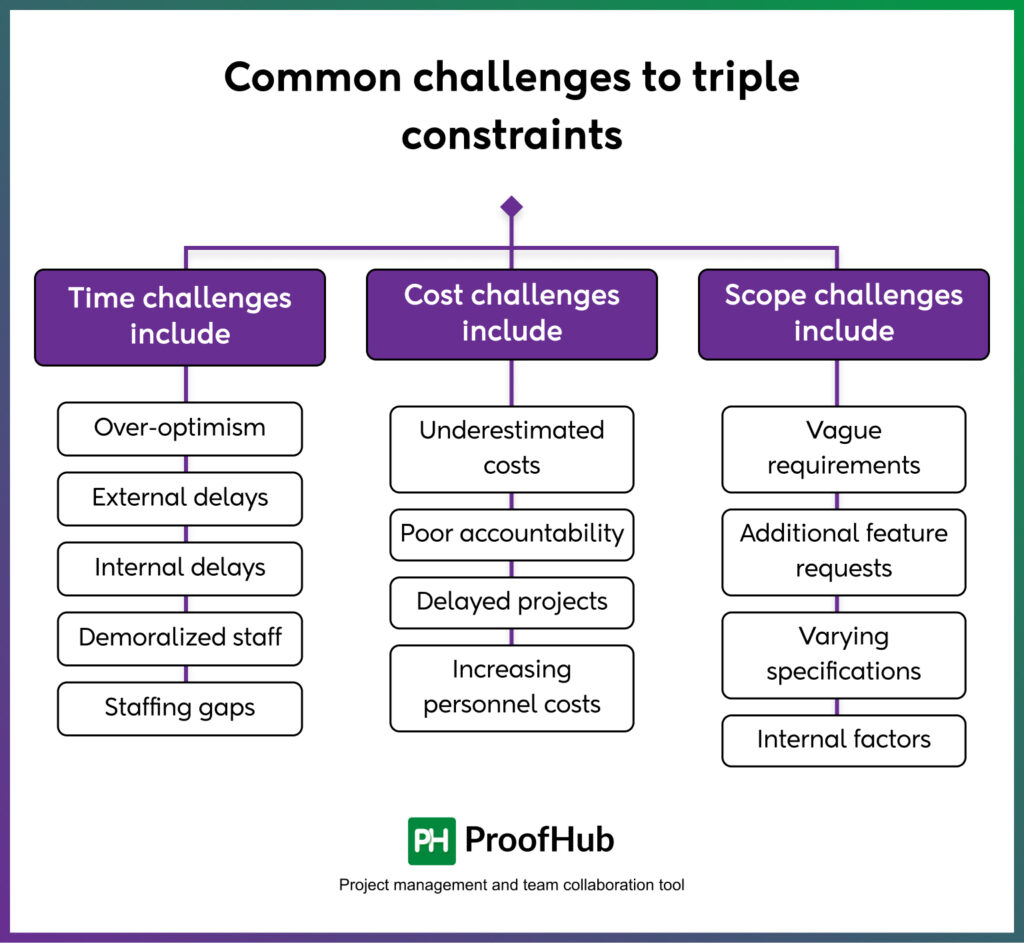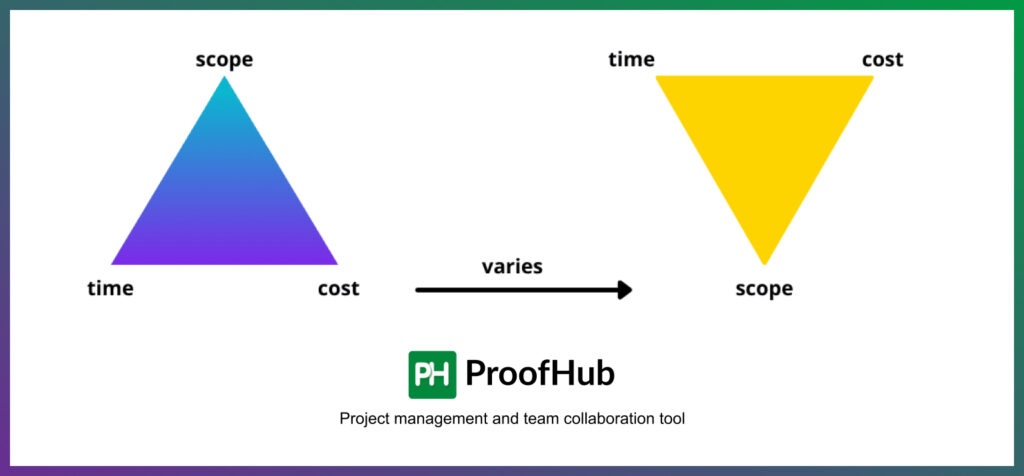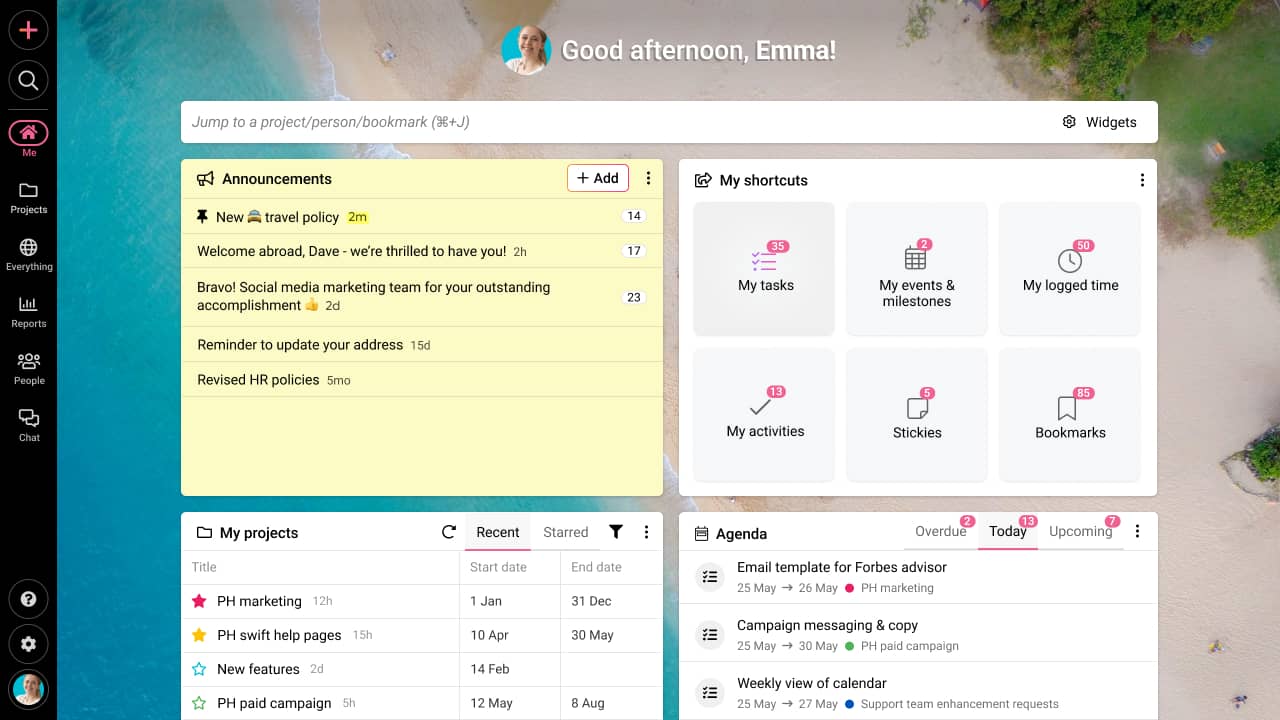The project management triangle is the tool project managers use to set realistic boundaries for a project.
In a perfect world, every project would be completed on time, within budget, and deliver exactly what was promised. However, the reality is often different. It’s a balancing act that every project manager knows too well—prioritizing one thing while adjusting the impact on the rest.
Understanding this delicate balance is crucial to managing projects effectively, as the decisions you make will shape the overall outcome.
In this article, we’ll learn all about the project management triangle, exploring its concept and the challenges it presents, along with practical strategies on how to implement it.
A Free guide to help you with proven ways to lead a project from start to finish, without confusion or jargon.

What is the project management triangle?
The project management triangle, also known as the iron triangle, is a model that represents the interconnectedness among three fundamental constraints in a project: Scope, Time, and Cost.
Every project begins with an idea, which is then translated into a tangible scope to be achieved within a specified timeframe. These two factors define the third pillar of the triangle: cost.
The interplay between scope and time fundamentally determines cost:
Cost = f(scope, time)
Typically, the scope of a project acts as the primary determinant of its cost. For example, constructing a 10-story building will cost more than building a 5-story one.
Time, on the other hand, has an inversely proportional relationship with cost. Shorter timelines usually require more resources, thus increasing costs.
Conversely, if the budget is fixed, project managers may need to adjust either the scope or increase the timeframe to stay within budget.
Simply put, the project management triangle represents three competing priorities: scope, time, and cost. These factors must be carefully balanced to ensure successful project delivery.
Importance of project management triangle
The project management triangle serves as a crucial framework for project managers to understand and manage the tradeoffs among the constraints within which a project operates. It acts as a tool for guiding decision-making and prioritization throughout the project life cycle.
It helps project managers:
- Set clear priorities: The triangle helps Identify which constraint is most critical for the project’s success. Is the deadline your biggest concern, or is staying within budget more important? This clarity helps the entire team focus on the right goals.
- Facilitate decision-making: When challenges arise, be it a scope change, budget overruns, or a tight deadline– the triangle acts as a decision-making tool. Project managers can assess how altering one element (like expanding scope) will impact the other two (such as increasing time or cost). This helps in presenting clear, realistic choices to stakeholders.
- Communicate expectations: The triangle helps communicate the inevitable trade-offs to stakeholders. If they want to add more features (scope) or reduce the project timeline, project managers can use the triangle to explain how these changes will require more resources and could impact (cost) the project quality and deliverables.
- Control scope creep: By anchoring decisions to the triangle, project managers can resist scope creep that leads to delays and cost overruns.
- Risk management: The triangle helps project teams anticipate risks. By keeping an eye on how shifts in one constraint affect others, project managers can proactively manage and mitigate potential delays or budget increases.
Using the PM triangle, project managers can monitor the budget, schedule, and scope of their projects. This model can be adapted to meet the requirements of almost any project.
Triple constraints of project management triangle
Time, Cost, and Scope are usually the three most important variables of the project management triangle.

These are often referred to as triple constraints. Read on to learn more about them.
1. Scope constraint
The scope constraint refers to the breadth and depth of the project, covering the specific objectives, deliverables, and tasks required to complete the project. Proper scope definition ensures that all stakeholders understand what the project aims to achieve, preventing misunderstandings later on.
However, scope creep—when additional features or tasks are added without adjusting time or cost—can significantly impact a project’s success. Unmanaged scope creep leads to missed deadlines and budget overruns. To manage scope effectively, it’s essential to establish a clear project charter, define deliverables upfront, and implement a solid change management process to assess any requests for scope changes. Regularly revisiting the scope throughout the project helps ensure alignment with the original objectives.
Additionally, setting measurable objectives within the scope allows project managers to track progress more effectively. Milestones should be defined early to mark key stages of the project, helping ensure that scope changes are justified, understood, and agreed upon by all involved parties.
2. Time constraint
Time constraint involves managing the project’s schedule, which includes setting deadlines for each task and phase and ensuring timely completion. Delays in one task often cascade, affecting subsequent tasks and potentially leading to missed project deadlines.
Time management techniques such as the Critical Path Method (CPM) or Gantt charts are useful for identifying essential tasks and their dependencies. By clearly understanding the critical path, project managers can better allocate resources and apply necessary time buffers to account for potential delays.
Teams often underestimate the amount of time needed for particular tasks, which can disrupt the entire project timeline. Time is also closely linked to resources. When resources are stretched thin, delays can occur, so it’s crucial to anticipate resource limitations early on.
3. Cost constraint
Cost constraint refers to managing the project’s budget, ensuring all expenses stay within the allocated financial resources. This entails labour costs, materials, equipment, and any contingency funds. Effective cost management requires continuous budget tracking and forecasting.
Budget overruns often occur due to poor initial estimates, changes in scope, or unexpected expenditures, which are common in long-term projects. To manage costs effectively, it’s important to conduct a thorough cost-benefit analysis early on, anticipate potential risks, and maintain a detailed budget log.
A key strategy for managing cost is regularly comparing actual spending with budget forecasts. Reducing costs might result in a compromised project, which can lead to long-term negative impacts on the outcome. Therefore, careful consideration must be given to how cost savings affect the overall project.
The fourth variable of quality

In addition to the primary constraints of scope, time, and cost, quality is the fourth variable that determines the success of any project. Quality is often viewed as a byproduct of how well the other three constraints are managed.
A project that meets deadlines and stays within budget but delivers a substandard product or service can still be considered a failure. Conversely, high-quality deliverables that require significant changes to the project’s scope, time, or cost may not meet stakeholders’ expectations.
Quality management involves setting clear standards for project deliverables and ensuring that all work adheres to those standards throughout the project lifecycle. This requires continuous quality monitoring, frequent testing, and stakeholder feedback to catch potential issues early.
Quality should not be compromised to meet time or cost constraints. Instead, building quality into each phase of the project, from planning to execution, ensures a consistent output that meets or exceeds stakeholder expectations. Balancing quality with scope, time, and cost is a complex but essential task for any project manager.
Strategies for managing project triangle constraints
Balancing the three constraints of the project management triangle requires strategic thinking and careful planning. Here are several strategies to help manage scope, time, and cost more effectively:
- Implement Work Breakdown Structure (WBS): Breaking down the project into smaller, manageable components clarifies the scope and allows for better tracking of individual tasks. A well-structured WBS ensures that all team members understand their responsibilities and deliverables.
- Use Critical Path Method (CPM): The CPM helps identify the longest chain of dependent tasks, allowing project managers to focus on tasks that directly impact the project’s completion date. Prioritizing these tasks ensures that delays are avoided and resources are used efficiently.
- Apply Earned Value Management (EVM): This technique measures project performance by comparing the planned work against the actual progress made. EVM allows project managers to detect variances early on and make necessary adjustments to keep the project on track.
- Regular budget reviews: Establish a process for ongoing budget reviews to spot discrepancies. Also, ensure all stakeholders are aware of the financial status throughout the project lifecycle.
- Develop a change control process: A formal change control process helps manage scope changes, ensuring that any requested changes are properly assessed for their impact on time and cost before being approved.
Common challenges to triple constraints
As we have read before, the triple constraints of time, budget, and scope are prone to many challenges that project managers must be aware of.

1. Challenges in managing scope
Managing scope presents challenges such as unclear or evolving requirements. When requirements are not well-defined at the project’s outset, it becomes difficult to establish a clear project roadmap. This often results in scope creep, where additional features or tasks are introduced without formal adjustments to time or cost.
Scope creep not only leads to missed deadlines but can also significantly inflate costs. To address these challenges, it’s essential to have a clear scope definition process and a strong change management system in place.
Another challenge is stakeholder misalignment. If all stakeholders don’t agree on the project’s scope, conflicts may arise that delay the project. Regular scope reviews and clear communication channels help align stakeholder expectations with the project’s goals.
2. Challenges in managing time
Time management challenges often stem from poor task estimation and unforeseen obstacles. Underestimating the time required for key tasks can derail the entire project schedule, leading to missed deadlines and rushed work.
Additionally, unforeseen delays—such as resource shortages, technical issues, or supplier delays—can disrupt the timeline. These challenges can be mitigated by building time buffers into the schedule, regularly updating the project plan, and monitoring task progress closely.
Another significant challenge is managing resource availability. Team members may be working on multiple projects simultaneously, which can lead to bottlenecks and delays. Ensuring proper resource allocation and maintaining flexibility in scheduling can help mitigate this risk.
3. Challenges in managing cost
Budget management challenges arise from inaccurate cost estimates, uncontrolled expenditures, and unforeseen financial demands. Projects can easily overrun their budget if cost forecasts are not based on thorough analysis or if additional resources are required.
Moreover, the difficulty in tracking project expenses in real-time can lead to undetected overspending until it is too late to correct. To address these challenges, project managers should continuously monitor the budget, conduct regular financial audits, and adjust financial forecasts based on real-time data.
Additionally, the pressure to cut costs can compromise quality, creating long-term issues for the project. Striking the right balance between maintaining financial discipline and delivering a quality product is key to successful cost management.
The project management triangle and agile methodology

In Agile software development, the project management triangle takes on a more flexible form. Unlike traditional models, Agile focuses on delivering smaller increments of a project over shorter time frames, which emphasizes adaptability over strict adherence to the original scope. Agile frameworks such as Scrum, Kanban, and Scrumban prioritize customer feedback and continuous improvement, making the balancing of project constraints more dynamic.
Agile’s iterative nature allows for greater flexibility in managing the triple constraint model. Instead of fixing scope from the start, Agile projects often fix time and cost, adjusting scope through product backlog refinements.
This approach keeps the team focused on high-priority tasks while allowing for risk management and quality assurance as the project evolves. The end user is frequently involved in feedback loops, helping ensure that the deliverables align with customer expectations and project goals.
Furthermore, the lean software development methodology also influences Agile by emphasizing the removal of waste, which can directly impact project cost and efficiency. As teams work through iterations, Agile encourages transparency and regular communication, facilitating better management of scope, time, and cost without compromising the project’s overall quality assurance.
ProofHub – best software for managing the project management triangle
Project managers have to ensure that they efficiently manage the project management triangle through proper planning, promoting seamless team communication, creating accurate estimates, and building a cross-functional team.

Using powerful and easy-to-use project management and team collaboration software can be of great help. ProofHub allows project managers to effectively manage the triple constraint with a suite of team collaboration and project management tools from a single location. ProofHub enables you to manage valuable resources smartly that enable you to make the right decisions at the right time.
Key features
- Task management: Helps scope management by allowing teams to break down tasks into manageable parts and track their progress, ensuring the project’s scope remains clearly defined and achievable.
- Time tracking: Enables accurate monitoring of project timelines, helping to manage time constraints by tracking how long tasks take and identifying potential delays early.
- Gantt Charts: Provides a visual timeline for the project, allowing teams to plan and adjust schedules as needed to avoid delays and manage time more effectively.
- Cost-effective solution: ProofHub’s flat pricing eliminates unexpected costs, allowing teams to manage budgets effectively and scale usage without additional financial burden.
- Resource allocation: Helps balance scope and cost by ensuring that team members are appropriately assigned to tasks, optimizing the use of resources without overspending.
- Project reports: Offers insights into project progress, helping with both scope and time management by identifying potential bottlenecks and ensuring projects stay on track.
By utilizing these features, ProofHub provides a comprehensive solution to balance the project management triangle, allowing teams to manage the key constraints effectively and keep projects on target.
Conclusion
The project management triangle offers a foundational framework, but it’s just one piece of the larger puzzle. As projects grow in complexity, understanding how time, cost, and scope interact is essential, but so is recognizing how they fit into broader project management practices like risk management, and collaboration tools all extend the capabilities of the triangle, helping teams not only manage constraints but also drive innovation and adaptability.
The project management triangle needs to evolve beyond a static model. Modern projects are about creating a dynamic balance and software solutions like ProofHub play an important role to manage the ever evolving complexities.
FAQs
What is a triple constraint triangle in project management?
The Triple Constraint Triangle, or Project Management Triangle, represents the three main constraints in project management: scope, time, and cost. These form the vertices of a triangle, showing their interconnected nature. Changes in one constraint typically affect the others.
Why is the project management triangle important?
The Project Management Triangle is crucial as it illustrates the balance between key project variables. It aids in decision-making, manages stakeholder expectations, and provides a framework for assessing project success and conducting trade-off analyses.
What are the phases of the project management life cycle?
The project management life cycle typically consists of five phases: initiation, planning, execution, monitoring and controlling, and closing. Each phase has specific objectives and deliverables, guiding the project from conception to completion.
How do changes in project scope affect time and cost?
Changes in project scope often have ripple effects on time and cost. Increasing scope usually requires more time and resources, while decreasing scope may reduce time and costs but could affect the project’s value. Scope changes can necessitate rework and impact resource allocation across the organization.

